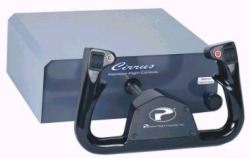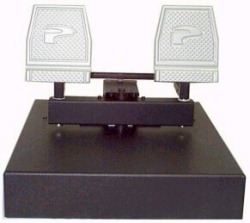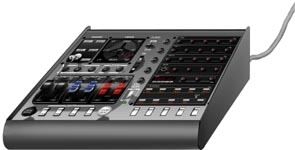|
Precision Flight Controls: The Best for Last
by Ed "Lozhechnik" Reddy with special guest reviewer Brendan "CDNAV8TR" Goss |
||||
|
Loz: Precision Flight Controls are based out of the US and are primarily into flight controls for commercial aircraft simulators. The past couple of years they have been selling their Cirrus yokes and rudder pedal sets to civilian flight simulation enthusiasts. Wanting to encompass all budget levels of yokes, I asked PFC to send me their set for review. One week later, UPS called to inform me that they had three large boxes from PFC but that there was over $50 in brokerage fees (for you Canadian readers, you can understand this UPS tactic.) The folks at PFC were great in handling this minor snafu and by that evening I had the packages in hand. Requiring assistance to handle "three mammoth boxes", I enlisted my friend and co-author of my ProPilot99 review, Brendan, to help me set up and evaluate the products. CDNAV8TR: That's me!
 Cirrus Yoke Loz: No doubt Bren. Inside the three boxes were the Cirrus Yoke (Jet Style), Rudder Pedals, and a PAL (Programmable Active Link). The yoke weighed in at a solid 20 pounds, and with dimensions of W 14" H 5 1/4" D 12" proved to be a bit interesting to set up. Brendan suggested that we place the control under my monitor.
 Cirrus Pedals With my brawn and his brains, I lifted my 40-pound monitor and while he placed the yoke control on the desk and I replaced the monitor on top. Brendan then quickly assembled the pedals while I connected the PAL. The pedals and yoke are connected via a Y-adapter that plugs into your game port. PAL setup is simply taking your keyboard and plugging it into the PAL, and then running a keyboard extension plug into the computer. There are no power adapters or special configurations required for any of the devices. CDNAV8TR: So what you're saying Ed is that it was a snap to connect with no hassle? Loz: Yes... no hassle. Ahem. Functionality/Interface (PAL) PFC and CH Technologies have worked out an agreement to use their F-16 Combatstick drivers. This means for users that you can rely on CH's excellent software interface with frequent driver updates. Our first step in setting up the yoke was to grab the latest CH drivers from their web site. Installation was a snap and when I added the yoke in the Windows control panel, it was instantly recognized. Brendan suggested that we first program the yoke to Fighter Squadron: Screaming Demons Over Europe(FS:SDOE). Our Yoke has 12 programmable buttons - four rocker switches and four buttons. Using CH's programming utility, we mapped out the trim on the 2 left rocker switches, fire button on button 1, bomb release on button 2, landing gear up/down and flaps up/down on the right rockers, target selection on button 3, and return to front view on button 4. The rudder pedals are equipped with two additional button functions that when pushed with the toe lean forward and engage a button function. |
 PAL Brendan suggested that I map the additional toe function to brakes as they are in real life. With our yoke programmed, I turned to the PAL (Programmable Active Link). The PAL works on the premise of overlaid glossy inserts working with software to re-map keyboard commands. These inserts are graphical representations of actual flight controls and have most of your basic cockpit functions. I'll let Brendan discuss the rest. The PAL CDNAV8TR: What I didn't like about the PAL was that there was no nice interface to design your own overlay. When I opened up the editing utility for the PAL, I was offered 96 functions to program however the interface seemed weak (Ed note: The interface was still an early beta). Point 2 is that the buttons are small and clumped together too close. When we were flying a B-29 using Flight Simulator98, Ed put in the FS98 template. I had difficulty trying to press the buttons and when I pressed the landing gear I got flaps. I next pressed the autopilot but it would not engage. Ed had to remove the overlay and replace it onto the PAL. This time all buttons worked properly but it required a direct press over the small area. All 96 buttons on the PAL are very small and close together with no physical outline. The PAL would be better served with perhaps 30 or 40 larger buttons with indented button positions. The PAL software on the other hand is simple yet not very functional, like Ed. Loz: Grrr...! like Brendan said the PAL is a very simple interface without much pizzaz and lacking in user friendly design. It is very easy to program key functions, but deciding which of the 96 keys to program is hard. The second point is that without a way to print off my design on a snazzy background like in the Saitek PC Dash, there is little functionality in programming the PAL for other commands. Later this month PFC is releasing a Developers Kit for the PAL, so we will have to wait and see what improvements are coming. Yoke and Pedals Back to the yoke and pedals. The unit has great functionality, with the twelve programmed switches and buttons located in easy to reach locations on the top part of the yoke. The throttle, however, is located in the same spot as the CH Flight Sim Yoke, but is the traditional/realistic pull/push style. Throttle adjustments while turning the yoke are not as difficult because it sits slightly outside the edge of the yoke. The only thing missing from the throttle is a tension twist lock that most small single engine planes use to "lock in" a throttle position. That aside, I can say I like the way this yoke functions. This is not a force feedback device, but if it was I can guarantee you that it would be even more amazing. Functionality Scores:
Go to Part II
|
|||
|
Copyright © 1997 - 2000 COMBATSIM.COM, INC. All Rights Reserved. Last Updated August 2nd, 1999 |
||||
